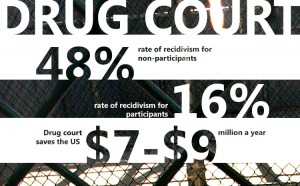If you ever find yourself in D.C. and want to see something other than the Washington Monument, take a break from D.C.’s swampy summer mornings and its muggy tourism to sit in on a session of drug court.
“Smart on crime is tough on crime,” read posters scattered around Robert F. Kennedy Department of Justice building.
A few blocks north is the Superior Court, where every few weeks, the “client” reports to a judge, who either praises progress or scrutinizes failures. Between meetings with judges are other appointments: therapy, rehab, group counseling, employment fairs. There is a revolving door of drug tests. Miss three meetings? Spend a night in jail. Another meeting, another night in lock-up. Water down your drug test, jail; when a client has spent a week or more in jail, they come back to the judge for a serious evaluation of their commitment to ridding themselves of the habit. But stay clean for a month, and the bailiff shakes your hand; the judge might give you a token, a ticket to a movie theater, an approving nod. Look beyond the court, and recidivism drops from 48% for non-participants to 16% for graduates of a drug court program.
The entire concept of a drug court is a new one, coaxed through Congress and jostled past factions that favored being tough on crime over new criminology-informed practices. The DoJ’s research arm, in conjunction with the White House, estimates that the U.S. saves $7 to $9 million a year from drug courts. Those savings affect small state and local courts; to help them use those savings effective, the DOJ shoulders nearly $35 million in constructing grant programs for potential drug court programs across the country.
A very particular set of people are in the business of making, interpreting, and enforcing the law. We know them by a variety of names: police, legislature, courts. But since 1870, the DOJ has been in the business of making sure laws are any good at what they’re meant to do before, during, and after a crime. In 2010, the DOJ budget was the 8th largest of any federal agency, totaling $24 billion (with another $4 billion of stimulus spending tacked on to the final budget). That funding is divided among a number of bureaus that operate under the DoJ, including the FBI, the DEA, and the U.S. Marshals, as well as the bureaus that handle immigration, prosecuting federal legal cases, and grant administration.
Defining the DoJ’s influence as strictly federal is insufficient when examining its purpose and its mission. As the Department’s drug program can attest, DoJ funds reach state and local levels, and extend all the way down to the individual. Of the money siphoned off to law enforcement, a portion went to hiring 50,000 police officers; another went to investment in the FBI across all 50 states, as well as funding attaché offices across the world that handle specialized transnational organized crime, narcotics operations, or counterterrorist initiatives. The Bureau of Prisons picked up another $6 billion to invest in prison infrastructure. The prisoner re-entry programs draw $109 million to provide access to housing, employment, and welfare for released prisoners in communities across the country.
Filing extradition requests for alleged distributors of child pornography who had the chutzpah to cross state lines; contacting trafficking victims across the nation to come together for a federal case in the state of origin; launching a website about the best solutions to crime for local law enforcement agencies; creating new support for offenders being introduced back into the community. To do it all is, sometimes, not to do it well; the recent Project Gunrunner scandal, in which the Bureau of Alcohol, Tobacco, Firearms and Explosives allowed dozens of assault weapons to be sold to Mexican drug cartels in a misguided effort to track them, looms heavy over the reputation of the DoJ. In a similar vein, many of the more abstract programs to be launched from the DoJ’s bully pulpit have a negligible effect on the most underfunded systems and can be pulled out from underneath them when the initial grant period runs through, leaving behind skeletal programs-that-once-were, the now-gone fingertips of the DoJ in some city, somewhere.
Is it worth it? Consider the need for a program like drug courts: in the U.S., 60% of felons are likely to commit another crime, addicts are less likely to kick the habit if shuttled off into prison for a stint on possession; there are over thirty-five different acts that constitute terrorism under federal law. For the DoJ, these are not just facts: they are strategies. Well beyond the tarring and feathering of its youth, the DoJ faces a complex and expansive task of providing funding, auxiliary support, research, data, and resources for crime prevention, response, and enforcement, both on the federal and the state level.
The Department of Education doesn’t pay for teachers, and the Department of Urban and Housing Development won’t settle your mortgage; but the DoJ will provide subsidiary funding for your courts, your prisons, and your police officers. Whether it’s disability pay for the widow of a cop or access to a drug counselor for a recovering addict, it’s the DoJ that foots some part of the bill from its federal perch.
Design by Melissa Wong
